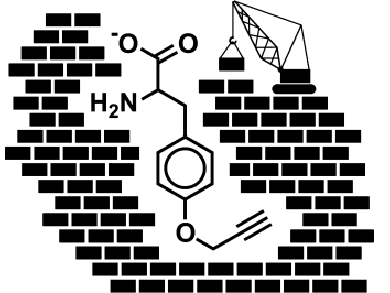Incorporation of Non-natural Amino Acids into Peptides
A single targeted mutation is enough to alter a natural peptide system so that it also incorporates non-natural amino acids into peptides, report Swiss scientists in the journal Angewandte Chemie. The mutation increases the size of the binding cavity in one domain of the system, which changes the substrate specificity. The researchers are thus able to incorporate amino acids with a specific reactive group that can later be used to easily modify the peptide.
Click Chemistry
In the search for new pharmaceuticals through the use of combinatorial chemistry and screening processes, researchers are often faced with the task of modifying and varying natural substances—sometimes by adding further molecular components, for example. Highly specific coupling with molecular markers is particularly important because it allows scientists to monitor the distribution of natural substances in cells and tissues. Coupling reactions that are almost as snapping components together can be carried out by a technique known as “click chemistry”. This method encompasses broadly applicable reactions like those between alkynes and azides, which deliver high yields.
Using Nonribosomal Peptide Synthetases to Include Reactive Groups
For this technique, the natural substance must first be equipped with such an alkyne or azide group. One way to achieve this would be through the incorporation of amino acids with alkyne or azide side chains into proteins through alteration of their biosynthesis. However, many interesting natural substances, such as the gramicidin antibiotics, are not formed by way of the classical pathways of protein biosynthesis through the reading of genes and the assembly of amino acids in the ribosomes. Instead, they are made by nonribosomal peptide synthetases, very large multi-enzyme complexes whose individual modules hang together like pearls on a necklace. These activate the amino acid building blocks and incorporate them into the growing peptide chain. The number, type, and ordering of the individual modules determine the length and composition of the resulting—usually short-chained—peptide. In addition to the usual amino acids, it is also possible to incorporate other, sometimes unusual, individual building blocks, which allows for the formation of an astonishingly large variety of peptides.
Researchers working with Donald Hilvert at the ETH in Zürich, Switzerland, exchanged an individual amino acid in one module of the nonribosomal production apparatus for the antibiotic gramicidin S through a mutation. This altered an area known as an A domain, which specifically recognizes and activates the natural amino acid phenylalanine. The mutation causes the binding cavity to be roomier, so that non-natural amino acids that contain an azide or alkyne group can be activated and incorporated into the peptide chain in place of phenylalanine. The catalytic activity of the overall system is not affected by this change in selectivity.
Because many different nonribosomal synthesis systems contain such A domains, this new method is potentially a general approach for equipping important natural substances with a reactive site for highly specific covalent modification.
- Reprogramming Nonribosomal Peptide Synthetases for “Clickable” Amino Acids
Hajo Kries, Rudolf Wachtel, Anja Pabst, Benedikt Wanner, David Niquille, Donald Hilvert
Angew. Chem. Int. Ed. 2014.
DOI: 10.1002/anie.201405281




